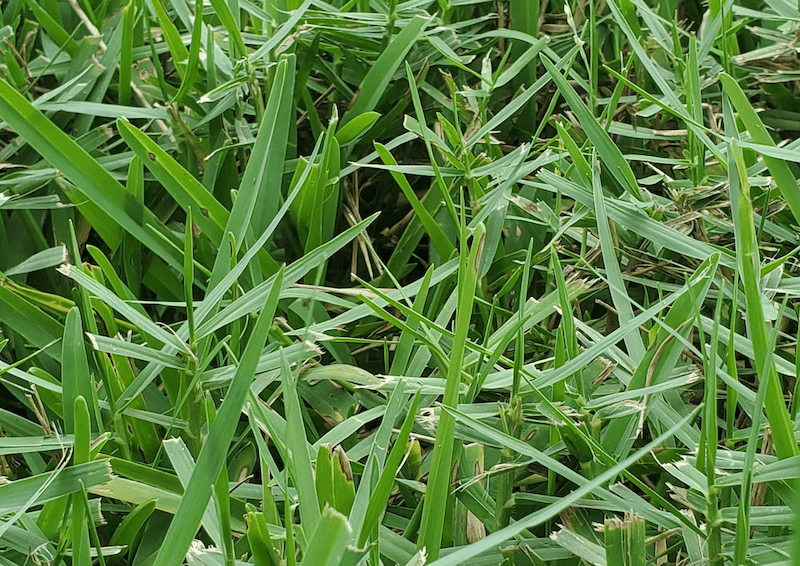In this guide to St. Augustine, we'll discuss everything from cost to best mowing height while also looking at the pros and cons. By the end, you'll be perfectly positioned to know whether it's the right sod type for you.
What Is St. Augustine Sod?
St. Augustine sod is a popular type of grass. We often see it in warm coastal areas. It loves the sun and can handle salty soils. This sod gives us a dense and lush lawn. One of its superpowers is shade tolerance. It beats many other grass types here.
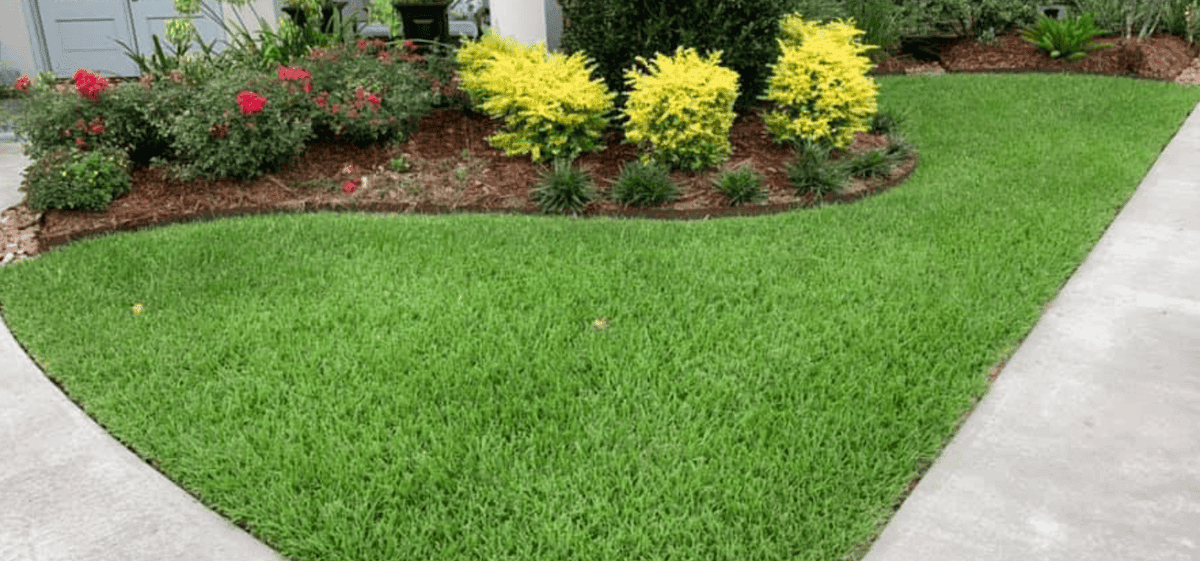
Characteristics:
Color: Dark green
Texture: Coarse blades
Growth: Forms a thick carpet quickly
Why do we choose it? It's great for our lawns because it recovers fast from damage. Also, we don't need to seed it, which saves us time.
Pros:
Shade-friendly
Drought-tolerant once established
Covers quickly with fewer weeds popping up
Cons:
Needs more water to start
Not frost-friendly
We often use it in places like Florida and Texas. It's perfect for our warm seasons. We lay the sod in strips or squares. This way, we can get a green yard fast.
Here's the drill when we lay down St. Augustine sod:
Prepare soil by clearing and leveling.
Install sod pieces tightly together.
Water generously at first.
Mow when it's about 3 inches tall.
Remember, we've got to care for it right. That means regular watering, and feeding it fertilizer. We do this, and we get a beautiful green carpet everyone loves.
Facts and Features
St. Augustine sod is popular for lawns. It loves warm climates. It's not a fan of the cold. We see this grass rocking thick, broad blades. They have this deep green color that's easy on the eyes.
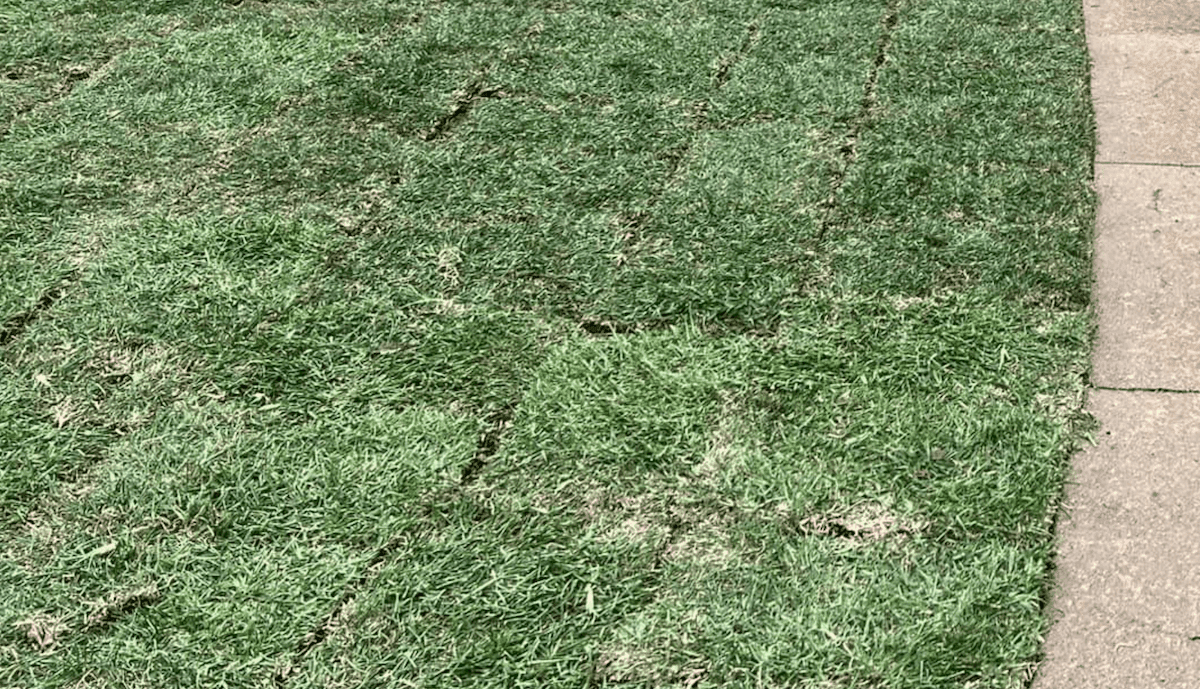
Growth Habit:
St. Augustine grass spreads fast. It uses runners, or "stolons."
It heals quick from damage. Think of it as the Wolverine of grasses.
Shade tolerance is its superpower. It's one of the few that can handle a sun break.
Maintenance Needs:
It's thirsty. Regular watering keeps it happy.
We mow it to an ideal height of 2.5 to 4 inches.
Fertilizing? We do it in spring and summer.
Texture and Color:
The blades are coarse. But still, they feel nice underfoot.
Those blades boast a rich green hue. They can make other grass types jelly.
Here's the rundown on climates and soil. St. Augustine sod thrives in warm regions like the Southern United States. It's not about that frost life. As for the soil, it's not too picky. But it does best in well-drained spots.
Climates & Soil:
Preferred Climate | Soil Type |
Warm, tropical | Well-drained |
Non-freezing | Any, but prefers sandy loam |
Quick heads up, this grass might need some pest control. Watch out for chinch bugs and grubs. Don't let them crash the party.
Keep in mind, its dense mat. It's superb for choking out weeds. But, remember, it can get invasive. Keep it in check, so it stays where we want it.
When to Lay St. Augustine Sod
Laying St. Augustine sod at the right time is crucial. It ensures strong roots and healthy growth. Let's dive into the specifics.
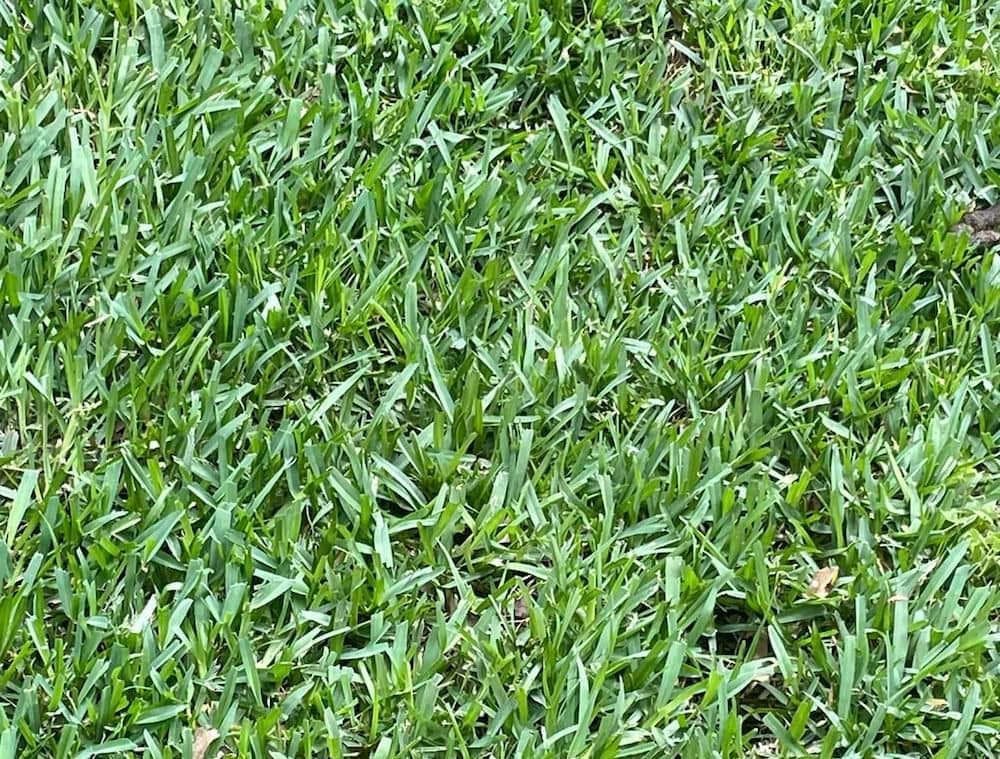
Soil Conditions
Before laying St. Augustine sod, make sure your soil is ready. The ideal soil temperature is 65°F or higher. This usually means we're looking at late spring or early summer. Here's what we need to do:
Test the soil pH: It should be between 5.0 and 8.5.
Till the soil: About 4 to 6 inches deep. It helps roots establish faster.
Add topsoil or compost: Aim for a 1-inch layer to enrich the soil.
Light Conditions
St. Augustine sod loves sunlight. It needs at least 4 hours of direct sun daily. Be mindful of where you're planting:
Full sun areas: These are perfect; lay sod any time during our growing season.
Shady spots: Use caution. If it's too shady, consider a different grass type.
Remember, late spring through early summer is your best bet. Ensure the soil is prepped and the area gets plenty of sun. That's our ticket to a lush lawn.
Where to Buy St. Augustine Sod
When you're on the hunt for St. Augustine sod, we've got plenty of options. Start with local nurseries and garden centers. They often carry a variety of grasses, including St. Augustine sod. It's fresh and ready for your lawn.
Don't overlook the big box home improvement stores. Places like Home Depot or Lowe's stock St. Augustine sod, especially in regions where it thrives. Call ahead to check availability. They might even have deals.
Here's a quick tip. Check online for sod farms near you. They're experts in grasses and have fresh sod for you to pick up or get delivered. Plus, you might snag some great advice on laying and maintaining your new lawn.
Level Up Your Lawn Skills
Once per week we'll send you an interview from someone who has mastered the art of lawn care.
If you're a fan of online shopping, online retailers are worth a look. Websites like Sod Solutions or The Sod Lot sell St. Augustine sod. But remember, shipping costs can add up because sod is heavy.
For those who love a good deal, keep an eye out for local classified ads. Platforms like Craigslist or Facebook Marketplace might have people selling excess sod from their own projects at a bargain.
Finally, hit up landscaping companies. They often have access to quality sod and could even install it for you.
Here's a quick breakdown of where we can find St. Augustine sod:
Local Nurseries/Garden Centers
Big Box Stores (Home Depot, Lowe's)
Sod Farms (local pickups and delivery)
Online Retailers (Sod Solutions, The Sod Lot)
Classified Ads (Craigslist, Facebook Marketplace)
Landscaping Companies
Just make sure to compare prices and check reviews. Happy sod hunting!
A Note on Measurement: Rolls, Pallets and Square Feet
When we're talking about St. Augustine sod, we measure in rolls, pallets, or square feet. Let's break it down.
Rolls:
Each roll typically covers about 10 square feet.
Handy for small patches.
Pallets:
A pallet can vary in coverage, but it's usually around 500 square feet.
Great for larger areas.
Square Feet:
The simplest way to measure sod needs.
Measure your lawn’s length and width, then multiply.
Quick Guide:
Unit | Coverage |
Roll | 10 sq ft |
Pallet | ~500 sq ft |
Remember, buy a bit extra. It helps with tricky spots and edges.
Pro Tip: Keep your measurements accurate. Use a measuring tape, not guesses. Save time and money!
We got this! Let's measure twice and order once. Happy sodding!
How to Pick a Company to Install New Sod
When we're ready to lay down St. Augustine sod, picking the right installation company is crucial for the best results. Let's look at how to estimate the costs involved.
Installer Pricing: Estimates, Quotes, and the Actual Cost
We know we should get several estimates before making a decision. Here's what to keep in mind with each estimate:
Prices
Look for itemized prices — we need to see what we're paying for.
St. Augustine sod varies in price, depending on quality and quantity.
Quotes
Written quotes are a must. We don't want to rely on verbal promises.
Check if the quote is a fixed price or an estimate that can change.
Actual Cost
Additional fees: Ask about delivery fees, preparation work, or aftercare services.
Payment terms: Are we paying upfront or after the job? It's important to know.
Getting these details helps us avoid surprises and makes comparing companies easier.
Key Characteristics of St. Augustine
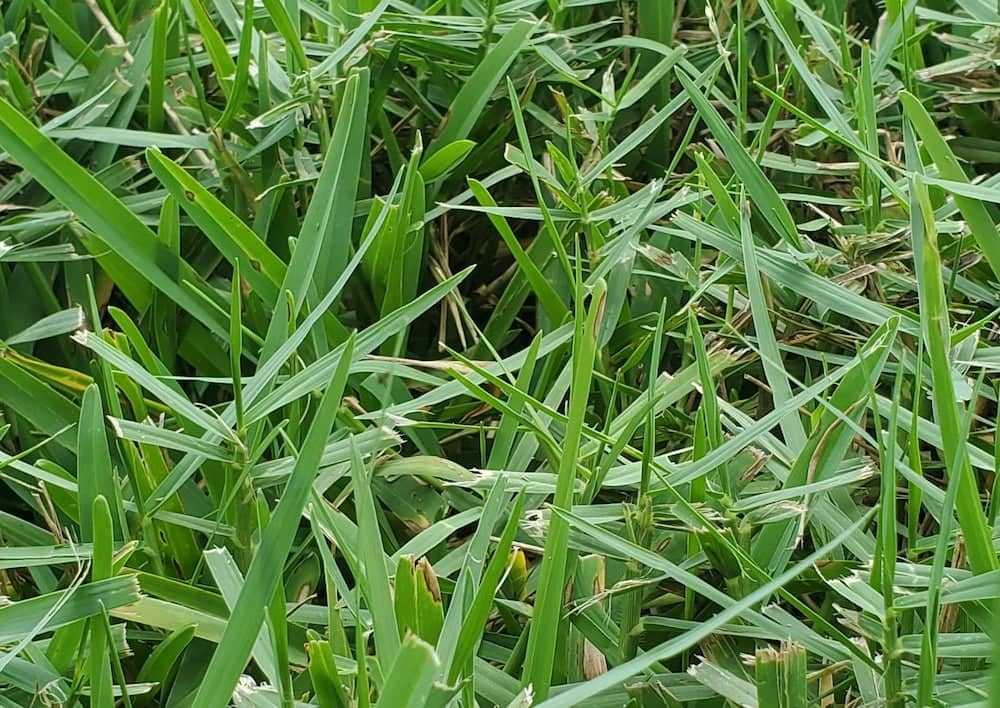
St. Augustine sod boasts features perfect for lawn enthusiasts. Let's check them out.
Durability and Resilience
We love St. Augustine grass for its tough nature. It thrives in warm climates and handles moderate foot traffic like a champ. This grass type can recover quickly from minor damage, making it ideal for active yards.
Dormant Season
Our St. Augustine lawns have a hibernation phase. During the cooler months, this grass goes dormant, usually when temperatures drop below 55°F. Its color fades, but don't worry; it’s just taking a break before spring.
Drought Tolerance
One of St. Augustine's superpowers is its drought tolerance. It can handle short dry spells pretty well. But we've got to give it a drink now and then. Long droughts? They can be tough on it.
Cold Tolerance
Here's the scoop: St. Augustine isn't a fan of the cold. It fares best in USDA zones 8-10. When the mercury dips, this grass might struggle. We do our best to keep it protected when things chill down.
How to Care for St. Augustine
Caring for St. Augustine sod means sticking to a few key practices. We'll focus on the essentials here.
Cleaning and De-Thatching
De-thatching is crucial. It involves removing dead grass that blocks water and nutrients. Every spring, we rake deeply to keep our sod healthy.
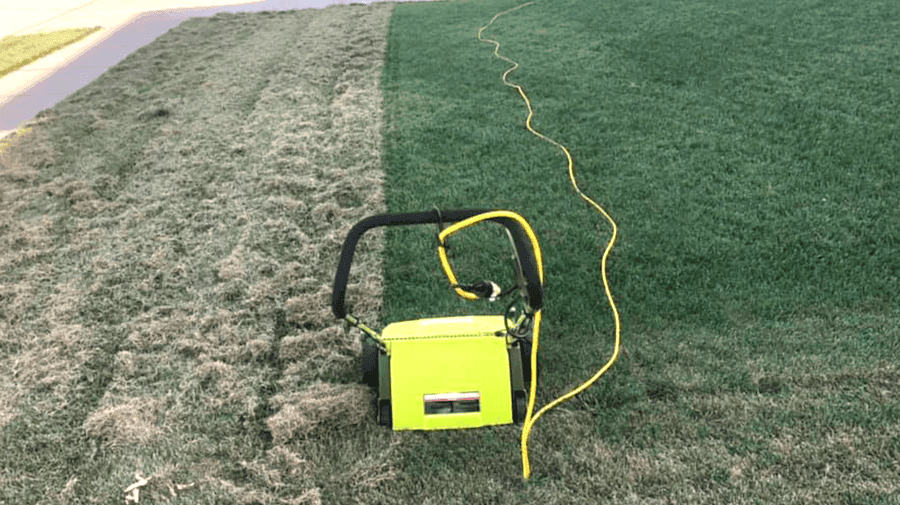
Core Aerating
Occasionally, our St. Augustine lawns need aerating. This alleviates soil compaction. We use a core aerator that removes small plugs of soil, boosting the air and water flow.
Mowing
Mowing is more than cutting grass. For St. Augustine sod, we:
Cut high: Usually around 2.5 to 4 inches.
Mow regularly: But never remove more than one-third of the blade at once.
Watering
Watering properly is non-negotiable. Our schedule looks like this:
Deep watering: We soak the soil to a depth of 4-6 inches.
Frequency: Depends on the weather. Usually, 1 inch per week is our target.
Fertilizing
We feed St. Augustine sod to promote lush growth. Our fertilizer plan includes:
Timing: Twice a year, in spring and late summer.
Product: We select a fertilizer with a 4-1-2 ratio of nitrogen, phosphorus, and potassium.
Controlling Pests
Pests can be a challenge, but we're ready. Our pest control tactics involve:
Identifying: We look out for signs of grubs and chinch bugs.
Acting: We apply eco-friendly pesticides when necessary. Always following local guidelines.
Pros & Cons of St. Augustine Sod
St. Augustine sod is popular, especially in warmer climates. Let's look at the ups and downs.
Pros:
Tolerance to Heat: It's a champ in the heat. Perfect for sunny areas.
Shade Endurance: It can handle some shade too.
Quick Cover: It grows fast, giving us a thick lawn quickly.
Weed Resistance: Once established, it crowds out weeds.
Coastal Friendliness: Salt spray? No big deal for this grass.
Here's a table summarizing the advantages:
Pros | Why It's Good |
Heat tolerance | Survives in hot climates |
Shade endurance | OK with less sun |
Quick to establish | Fast lawn coverage |
Natural weed resistance | Fewer weeds in the lawn |
Tolerance to salt spray | Great for coastal areas |
Cons:
Water Needs: Thirsty! It requires regular watering.
Cold Sensitivity: Cold snaps? That's trouble for St. Augustine.
Pest Attraction: Chinch bugs love it, unfortunately.
Maintenance: It asks for our attention with frequent mowing.
Check out this quick cons list:
Cons | What It Means |
High water needs | More watering, higher bills |
Cold sensitivity | Not for freezing temperatures |
Pest attraction | Bug problems can pop up |
Maintenance demands | Time spent on lawn care |
We've got St. Augustine sod's strengths and weaknesses covered. It's good to know before we decide, right?
Frequently Asked Questions
We've got your back with the most common questions about St. Augustine sod. Let's dive in.
What's the ideal fertilizing schedule for my St. Augustine lawn?
For our St. Augustine lawns, we stick to a fertilizing routine to keep it lush. Start in spring with a balanced fertilizer. Repeat every two months during the growing season. Don't forget a winterizer in the fall.
Is it possible to plant St. Augustine grass from seed, or should I use sod?
We can't grow St. Augustine grass from seed easily—it's a challenge. Sticking to sod or plugs is our best bet. Experts recommend it for a full, healthy lawn.
Can St. Augustine sod be laid directly over an existing lawn?
We don't lay St. Augustine sod over old grass. It's a no-go. We clear the area first to give the sod a fighting chance. That means removing old turf and prepping the soil.
How long does it generally take for St. Augustine sod to root and become established?
Our experience tells us it takes about 7-14 days for the sod to root well. For full establishment, we're looking at about 4-6 weeks with proper watering and care. Keep traffic light during this time.
Does St. Augustine grass thrive in Florida?
Yes, St. Augustine grass is well-suited to the warm, humid climate of Florida. It's an excellent choice for most Florida lawns, as it can tolerate both drought and high temperatures. Additionally, the grass is resistant to salt spray, making it ideal for coastal areas.
St. Augustine versus other types of sod
- St. Augustine vs. Bermuda comparison →
- St. Augustine vs. Buffalo comparison →
- St. Augustine vs. Zoysia comparison →
- St. Augustine vs. Tall Fescue comparison →
- St. Augustine vs. Kentucky Bluegrass comparison →
- St. Augustine vs. Perennial Ryegrass comparison →
- St. Augustine vs. Centipede comparison →
- St. Augustine vs. Fine Fescue comparison →
- St. Augustine vs. Bahia comparison →
Level Up Your Lawn Skills
Once per week we'll send you an interview from someone who has mastered the art of lawn care.

